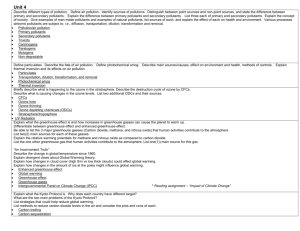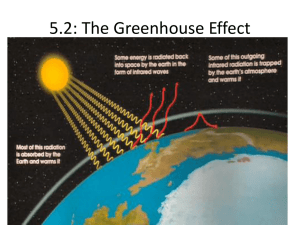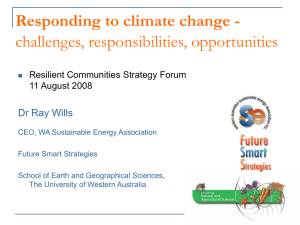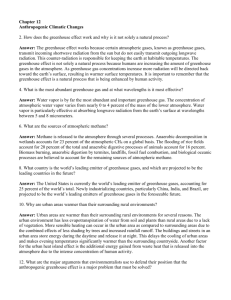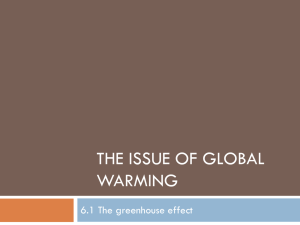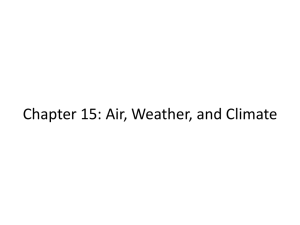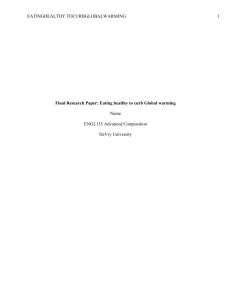CHAPTER 12 ANTHROPOGENIC CLIMATIC CHANGES
advertisement
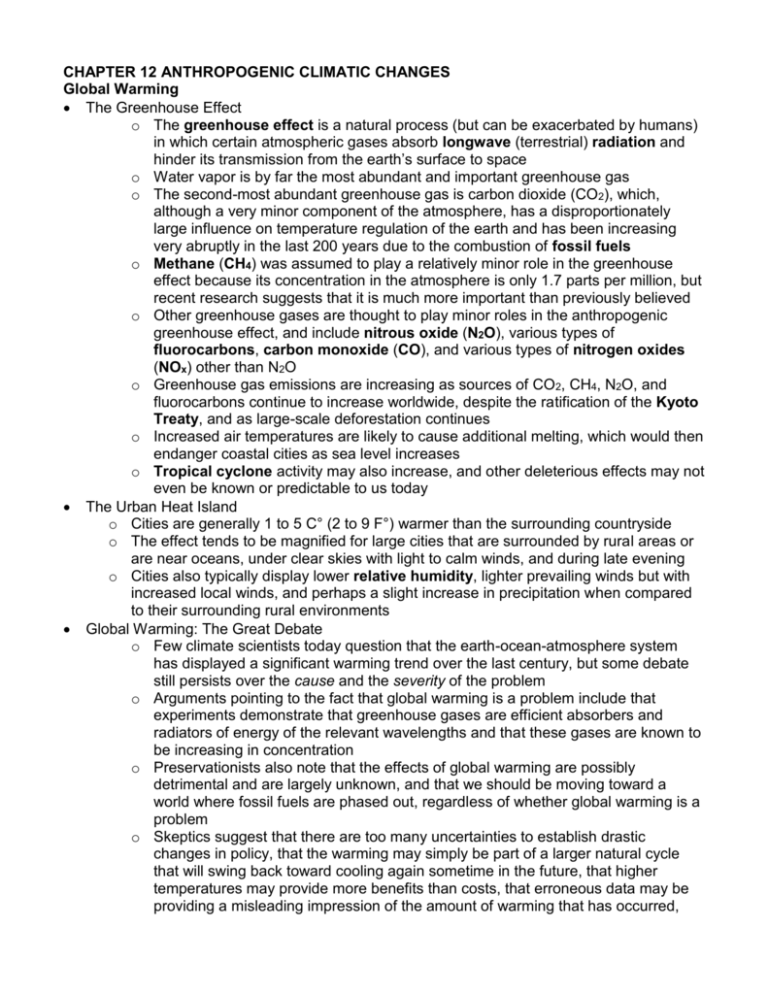
CHAPTER 12 ANTHROPOGENIC CLIMATIC CHANGES Global Warming The Greenhouse Effect o The greenhouse effect is a natural process (but can be exacerbated by humans) in which certain atmospheric gases absorb longwave (terrestrial) radiation and hinder its transmission from the earth’s surface to space o Water vapor is by far the most abundant and important greenhouse gas o The second-most abundant greenhouse gas is carbon dioxide (CO2), which, although a very minor component of the atmosphere, has a disproportionately large influence on temperature regulation of the earth and has been increasing very abruptly in the last 200 years due to the combustion of fossil fuels o Methane (CH4) was assumed to play a relatively minor role in the greenhouse effect because its concentration in the atmosphere is only 1.7 parts per million, but recent research suggests that it is much more important than previously believed o Other greenhouse gases are thought to play minor roles in the anthropogenic greenhouse effect, and include nitrous oxide (N2O), various types of fluorocarbons, carbon monoxide (CO), and various types of nitrogen oxides (NOx) other than N2O o Greenhouse gas emissions are increasing as sources of CO2, CH4, N2O, and fluorocarbons continue to increase worldwide, despite the ratification of the Kyoto Treaty, and as large-scale deforestation continues o Increased air temperatures are likely to cause additional melting, which would then endanger coastal cities as sea level increases o Tropical cyclone activity may also increase, and other deleterious effects may not even be known or predictable to us today The Urban Heat Island o Cities are generally 1 to 5 C° (2 to 9 F°) warmer than the surrounding countryside o The effect tends to be magnified for large cities that are surrounded by rural areas or are near oceans, under clear skies with light to calm winds, and during late evening o Cities also typically display lower relative humidity, lighter prevailing winds but with increased local winds, and perhaps a slight increase in precipitation when compared to their surrounding rural environments Global Warming: The Great Debate o Few climate scientists today question that the earth-ocean-atmosphere system has displayed a significant warming trend over the last century, but some debate still persists over the cause and the severity of the problem o Arguments pointing to the fact that global warming is a problem include that experiments demonstrate that greenhouse gases are efficient absorbers and radiators of energy of the relevant wavelengths and that these gases are known to be increasing in concentration o Preservationists also note that the effects of global warming are possibly detrimental and are largely unknown, and that we should be moving toward a world where fossil fuels are phased out, regardless of whether global warming is a problem o Skeptics suggest that there are too many uncertainties to establish drastic changes in policy, that the warming may simply be part of a larger natural cycle that will swing back toward cooling again sometime in the future, that higher temperatures may provide more benefits than costs, that erroneous data may be providing a misleading impression of the amount of warming that has occurred, and that observed cooling from 1945 to 1980 should not have occurred if emission of greenhouse gases is to blame o The debate over global warming has been divisive, with scientists on each side sometimes accusing the other of propagating weak and faulty science at the expense of fairness and objectivity, to pursue their own agendas o The vast majority of atmospheric scientists support the notion that anthropogenic influences have, and are, significantly impacting the climate system o There are still many unresolved anthropogenic global warming issues among scientists regarding how societies should implement policy related to the issues Atmospheric Pollution Aside from its other effects, polluting the atmosphere allows more insolation to be reflected and scattered back out to space before it reaches the earth o Pollution may be masking the thermal effects of increased greenhouse gas emissions to some extent Global Dimming o The observed decreasing trend in insolation striking the earth over recent decades o The temperature may continue to climb in some cases even under increasing pollutants because cloud cover from pollution and aerosols may increase nocturnal temperatures by impeding longwave radiation loss to space o Pollution abatement in the last 15-20 years may be at least partially responsible for the recent reversal of the global dimming trend Atmospheric Factors Affecting Pollution Concentrations o Atmospheric stability/presence of anticyclones and associated cold ocean currents o Wind can disperse pollutants, but can also transport it long distances o Insolation can trigger photochemical pollution Air Quality Legislation in the United States o Air Pollution Control Act of 1955 was the first attempt at federal oversight in the United States o The Clean Air Act of 1963, with several subsequent amendments (most notably in 1970), became the first major effective legislation for regulating air quality and monitoring both stationary sources, such as power plants, and mobile sources, such as automobiles Classifying Air Pollutants By Response o Threshold pollutants are contaminants that are not known to be harmful in sufficiently small concentrations but that elicit a response after the concentration exceeds a particular threshold o Non-threshold pollutants evoke a response as soon as they exist at any concentration By Source o Primary pollutants are those solids, liquids, or gases that are emitted directly by human activities, such as Sulfur oxides, carbon monoxide, particulates, lead, and nitrogen oxides o Secondary pollutants arrive in the atmosphere as a by-product of chemical reactions between primary pollutants and/or other matter or energy in the atmosphere, such as industrial smog, photochemical smog, and acid precipitation Reactions and Attitudes to Climatic Change Prevention refers to tactics designed to reduce a potential threat Mitigation refers to attempts to decrease the risk associated with a threat, rather than decreasing the threat itself Adaptation refers to simply living with a threat and the consequences associated with the threat Continued Research – can take the modeling or empirical approach, or some combination of the two

